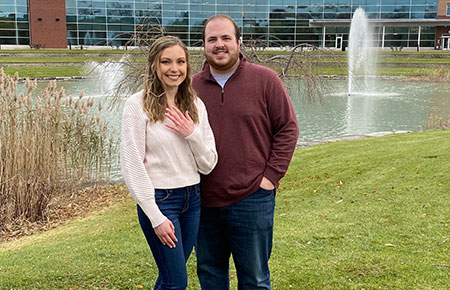After Years of Debilitating Wrist Pain Occupational Therapist Finds Success with Henry Ford
 A competitive cheerleader in high school and runner in college, Emily Kaminski of Livonia was very athletic growing up. She describes herself as someone who lived a pretty normal life.
A competitive cheerleader in high school and runner in college, Emily Kaminski of Livonia was very athletic growing up. She describes herself as someone who lived a pretty normal life.
Healthwise things changed during her last semester of graduate school while completing her master’s degree in occupational therapy at Eastern Michigan University. Emily began to experience an array of health issues. As she was learning about the different hand conditions and injuries in occupational therapy school, little did she know that she would be applying what she learned on herself.
“It was like a domino effect that started with my right hip pain, due to a running injury,” she says. In January 2021, Emily had major hip surgery and around that time, began to experience wrist and thumb pain in both hands. Her hip surgeon was the first person to tell her she might have Hypermobile Ehlers- Danlos Syndrome (hEDS). The connective tissue disorder impacts the joints and led to daily chronic pain, due to her hypermobility and number of injuries.
“Recovering from major hip surgery with two injured hands was extremely challenging,” Emily explains.
The effects of debilitating wrist pain
Emily began experiencing wrist pain in September of 2020 and says it was very debilitating for several years.
“When I first started experiencing the pain, it was a constant burning sensation and I felt like I could barely use my hands,” said Emily. This impacted every aspect of her life, from daily living to working as an occupational therapist. “I remember having a hard time with the simplest tasks, such as using a spoon to feed myself.”
Emily experiences a challenging diagnosis firsthand
 After seeing many hand surgeons, doctors commented that ulnar sided wrist pain, which occurs on the side of the wrist opposite the thumb, is challenging to diagnose.
After seeing many hand surgeons, doctors commented that ulnar sided wrist pain, which occurs on the side of the wrist opposite the thumb, is challenging to diagnose.
“My previous hand surgeons suspected Extensor Carpi Ulnaris (ECU) tendonitis, ulnar impaction syndrome and a triangular fibrocartilage complex tear (TFCC), but none of them seemed confident in their diagnosis and surgical plan. I tried steroid injections, rest, ice, splinting, and occupational therapy, but nothing helped,” says Emily.
After being told by one of her previous hand surgeons that she should stop getting so many opinions because she would just be confusing herself, Emily emphasizes she’s glad she didn’t listen and continued to trust her gut while searching for the right doctor.
New hope with Dr. Day
As she continued to search for the right doctor, she found out about Charles Day, M.D., Henry Ford Health orthopedic surgeon who specializes in hand and wrist surgery, through the Southeast Michigan Ehlers-Danlos Syndrome (EDS) support group.
“I knew that he was knowledgeable of EDS, so that’s why I decided to make the appointment.”
Emily says when she met Dr. Day, she immediately felt more confident. “He was very thorough during his examinations, and because he took the time to better understand me as a patient, he uncovered problems that other doctors missed.”
Emily’s left hand was feeling better and did not require surgery, but her right hand required treatment. She was diagnosed by Dr. Day with a torn TFCC and distal radial ulnar joint (DRUJ) instability in her right wrist. A (TFCC) open repair surgery on her right wrist was done in July 2023 to improve the stability in her wrist.
 Dr. Day explains that Emily likely sought a 3rd opinion because her diagnosis did not match what the MRI reported diagnosis was.
Dr. Day explains that Emily likely sought a 3rd opinion because her diagnosis did not match what the MRI reported diagnosis was.
“We know that in the hand surgery world, over 50% of the diagnoses on MRI findings of the wrist do not match with the patient’s actual symptoms,” says Dr. Day.
He noted whenever there is a discrepancy between a patient’s physical exam and the location of pain versus any radiographic findings, he puts trust in what the patient experiences with symptoms.
“Based on Emily’s symptoms, I performed a TFCC repair to bone, which probably would not have been necessary based on the MRI results alone. Moreover, I have experience treating EDS patients and we were able to take advantage of the hyperlaxity in her joints and immobilize her wrist after surgery longer than I typically do for my non-EDS patients.”
After the surgery, Emily wore a cast for 12 weeks versus the typical 8 weeks due to her connective tissue disorder. She also saw a certified hand therapist for a little over two months to improve her range of motion and strength.
The great news for Emily is since the surgery she has been pretty much pain free, and her hand feels much more stable. “I’m now able to complete daily tasks much easier and the burning sensation in my wrist is gone.”
 She adds that as someone who has experienced an array of health issues and has seen many doctors over the past three years, she is grateful for the kindness of Dr. Day and the Henry Ford physician assistants and staff. “I cannot thank them enough for everything they have done for me and for giving me back my quality of life.”
She adds that as someone who has experienced an array of health issues and has seen many doctors over the past three years, she is grateful for the kindness of Dr. Day and the Henry Ford physician assistants and staff. “I cannot thank them enough for everything they have done for me and for giving me back my quality of life.”
With successful hand surgery out of the way, Emily looks forward to spending quality time including traveling together with her supportive husband.
“I recently married my high school sweetheart of 10 years, Daniel Kaminski, and he has been such a huge support throughout all of this. He is truly keeping his word to our wedding vows, “through sickness and in health.”
Visit henryford.com/hand to learn more about how our team can help you find relief from your hand and wrist pain.
.svg?iar=0&hash=F6049510E33E4E6D8196C26CCC0A64A4)

/hfh-logo-main--white.svg?iar=0&hash=ED491CBFADFB7670FAE94559C98D7798)